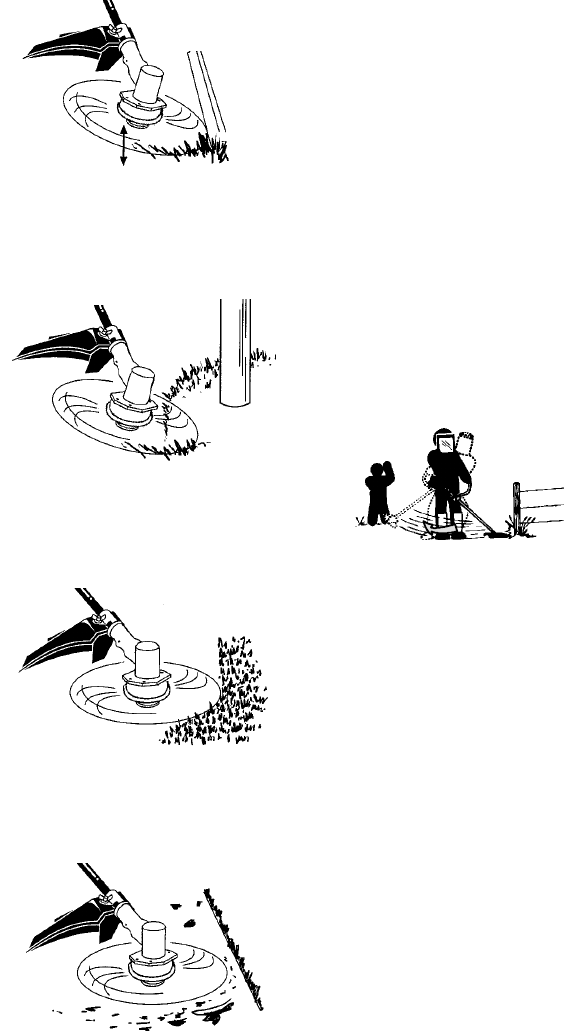
10
Trimming
3 inches (8 cm)
above ground
SCALPING -- The scalping technique re-
moves unwanted vegetation down to the
ground. Hold the bottom of the trimmer head
about3 inches(8cm)abovetheground a ndat
an angle. Allow the tip of the line to strike the
ground around trees, posts, monuments, etc.
This technique increases line wear.
Scalping
MOWING-- Yourtrimmeris idealformowingin
places conventional lawn mowers cannot
reach. In t he mowing position, keep the line
paralleltotheground. Avoidpressingthehead
into t he ground as this can scalp the ground
and damage the tool.
Mowing
SWEEPING -- The fanning action of the rotat-
ingline canbeusedto blowaway loosedebris
from an area. Keep the line parallel to and
above the area surface and swing the tool
from side to side.
Sweeping
OPERAT ING INSTRUCTIONS FOR
BRUSHCUTTER ATTACH MENT
S Bla d e T h rust is a reaction that only occurs
when using a bl aded unit. This reaction can
cause serious injury such as amputation.
Carefully study this section. It is important that
you understand what causes b lade thrust,
how you can reduce t he chance of its occur-
ring, and how you can remain in control of unit
if blade t hrust occurs.
S WHAT CAUSES BLADE THRUST -- Blade
Thrust can occur when spinning blade con-
tacts anobject thatit doesnot cut. This contact
causes blade to stop for an instant and t hen
suddenly move or “thrust” a way from object
that was hit. The “thrusting” reaction can be
violent enough to cause operator to be pro-
pelled in any direction and lose control of unit.
The uncontrolled unit can cause serious injury
if blade contacts operator or others.
S WHEN BLADE THRUST OCCURS --
Blade Thrust can occur without warning if
the blade snags, stalls, or binds. This is
more likely to occur in areas where it is diffi-
cult to see the material being cut. By using
the unit properly , the occurrence of blade
thrust will be r educed and the operator will
be less likely to lose control.
S Cutonly grass, weeds, andwoody brush upto
1/2 i nch (1 cm) in diameter with weed blade.
Do not let blade contact material it cannot cut
such as stumps, rocks, fences, metal, etc., or
clusters of hard, woody brush with a diameter
greater than 1/2 inch (1 cm).
S Useasharpblade.Adullbladeis morelikely
to snag and thrust.
S Cut only at full throttle. T he blade will have
maximum cutting power and is less likely to
bind or stall.
S “Feed” the blade deliberately and not too
rapidly.The bladecan thrust away if it is fed
too rapidly .
S Cut only from your left to your right. Cutting on
right side of the shield will throw debris a way
from the operator .
S Use the shoulder strap and keep a firmgrip
on the unit with both hands. A properly ad-
justed shoulderstrap willsupport theweight
of the unit, freeing your ar m s and hands to
control and guide the cutting motion.
S Keep feet comfortably s pread apart and
braced f or a possible sudden, rapid t hrust o f
unit. Do not overreach. Keep firm footing and
balance.
S Keep blade below waist level. It will be eas-
ier to maintain control of unit.
S Do notraise theengine aboveyour waistas
the blade can come dangerously close to
your body.
S Do not swing the unit with such force t hat
you are in danger of losing your balance.














